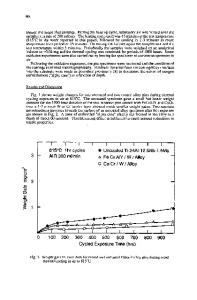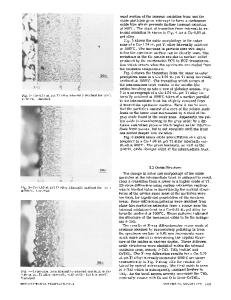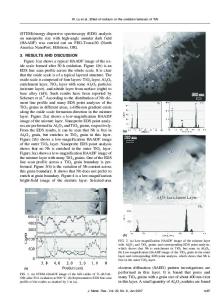Effect of nitrogen on the oxidation behavior of Ti 3 Al-based intermetallic alloys
- PDF / 423,004 Bytes
- 8 Pages / 612 x 792 pts (letter) Page_size
- 39 Downloads / 343 Views
I.
INTRODUCTION
THE oxidation behavior of intermetallic Ti3Al, with and without the addition of niobium, has been the subject of many earlier studies.[1–6] Ti3Al suffers from poor oxidation resistance, because the scale does not consist of protective Al2O3 but rather TiO2 or a mixture of TiO2 and Al2O3. In general, addition of Nb improves the room-temperature ductility[7] and also increases the oxidation resistance of Ti3Al.[2–5] The effect of gas composition on the oxidation behavior of titanium aluminides is significant with regard to rates, reaction product composition, and morphology. Choudhury et al.[8] concluded that the faster oxidation of TiAl in air as compared to that in oxygen is due to the presence of nitrogen in air. Meier et al.[9] observed that protective alumina scales formed on TiAl upon exposure in oxygen up to 1000 7C, while the same exposure in air resulted in the formation of titania-rich scale exhibiting faster growth rates. Even trace amounts of N2 influenced the oxide morphology. Meier et al. suggested that the presence of nitrogen caused a nitride layer to form which prevented the development of a continuous alumina scale. In a recent study on oxidation of TiAl in air, Rakowski et al.[10] reported the formation of intermixed TiN and Al2O3 rather than a layered scale. This prevented development of a continuous alumina layer leading to accelerated rates in air. Moreover, higher rates were maintained in the presence of a continuous supply of nitrogen. According to Rakowski et al., this indicated that the mixed oxide layers were permeable to nitrogen. T.K. ROY, formerly Graduate Student, Department of Materials and Metallurgical Engineering, Indian Institute of Technology, is Assistant Manager, Scientific Services, Tata Iron and Steel Company, Jamshedpur 831 007, India. R. BALASUBRAMANIAM, Assistant Professor, and A. GHOSH, Professor, are with the Department of Materials and Metallurgical Engineering, Indian Institute of Technology, Kanpur 208 016, India. Manuscript submitted March 6, 1996. METALLURGICAL AND MATERIALS TRANSACTIONS A
Several studies have demonstrated the positive role of niobium in improving the oxidation resistance of Ti3Al, in oxygen as well as in air.[2,3,4] However, the role of nitrogen has not yet been adequately studied. It is interesting to note that unlike in TiAl,[8,9,10] nitrogen has a beneficial effect on the oxidation of Ti3Al-based alloys.[2] Qiu et al.[11] has attributed the improved resistance to oxidation of Ti3Al, with 11 at. pct Nb or 5 at. pct Si or combined addition of both, to the formation of TiN and reduction of porosity in the oxide scale, rather than to continuous alumina layer formation. A detailed study of the oxidation of Ti3Al-based intermetallic alloys has been recently conducted over a wide range of temperatures and gas compositions.[12] The oxidation behavior of these alloys in dry oxygen[13] and the role of carbon dioxide[14] have been presented elsewhere. The present article focuses on the effect of nitrogen on the oxidation behavior of three
Data Loading...











